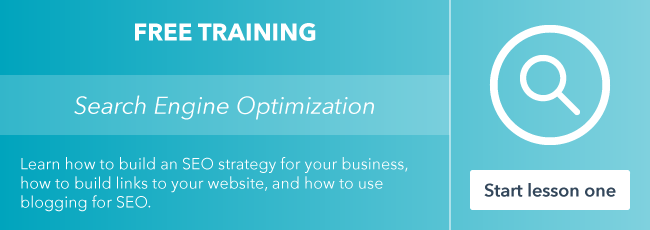As an Implementation Specialist, I wave goodbye to clients who have finished their marketing implementation process with HubSpot, and I welcome approximately 10 more into my funnel. Goal setting conversations are pretty similar across the board:

"I want to generate more leads, grow my business, and scale that growth," seem to be the prevailing reasons why small to mid size businesses purchase a marketing solution.
In determining where to start with our marketing in order to meet those lead generation goals, I always start with three basic strategies. These quick wins take no more than a couple hours to implement (if that), yet 9 out of 10 companies don't have these set up by the time we sit down to discuss what they're doing to capture prospects.
Today, I'm going to show you those three basic marketing components and how they will impact your business.
1. Solving for High Bounce Rates
Most clients who are exploring a marketing strategy for the first time have higher than average bounce rates on their site (56-70%), and a select few who may be investing heavily in PPC may be seeing exceptionally high bounce rates (70%+). Solving for this in its entirety is a long-term play and has a lot to do with the content and conversion opportunities on your site. However, there are ways in which we can use a higher-than-average bounce rate to our advantage while we get our content strategy up and running.
Think about it: if you have 1000 visitors to your site a month with a bounce rate of 56%, that's 560 visitors coming to your site each month that leave before interacting with your content (And that's on the lower end of high bounce rates)! Even if you're a smaller business and are seeing half that traffic, that's still 280 unique visitors you could be marketing and selling to.
It is likely you will never see those 560 visitors again. So, how are you going to capture those prospects before they leave? The answer isn't a prettier website or a static call-to-action above the fold.
The answer is: putting a pop-in mechanism where the highest concentration of your traffic exists: upon exit intent.
A pop-in functions like a pop-up but instead of bringing the visitor to a page outside of yours, it comes up inside your site (hence the name pop-in). Pop-in applications (which I'll discuss in a bit) typically give you the ability to determine when you want the pop-in to come up.
If your bounce rates are above 56%, set it to show upon exit intent. Exit intent is determined by the application when a visitor's mouse leaves your site to browse the navigation bar. This of course can only mean that your prospects are on their way out to either jump to a different tab or ex out of your site entirely.
By grabbing your prospects' attention right as they leave, it's important to provide an enticing enough offer to get them to stay. What do you have to offer? Is it a white paper? Is it 15 minutes of your time? Remember, most people who leave your site aren't leaving it because they've been offended or hate what you have to say. They simply have not found what they're looking for.
How can you make it easier for them to find their solution? Once you're able to nail that down, you're good to go. Just remember to add a little behavioral psychology flare by including a "Before you go!" call out, and you've got yourself a lean, mean, high bounce rate breaking machine.
Here's what it looks like when you've set it up:
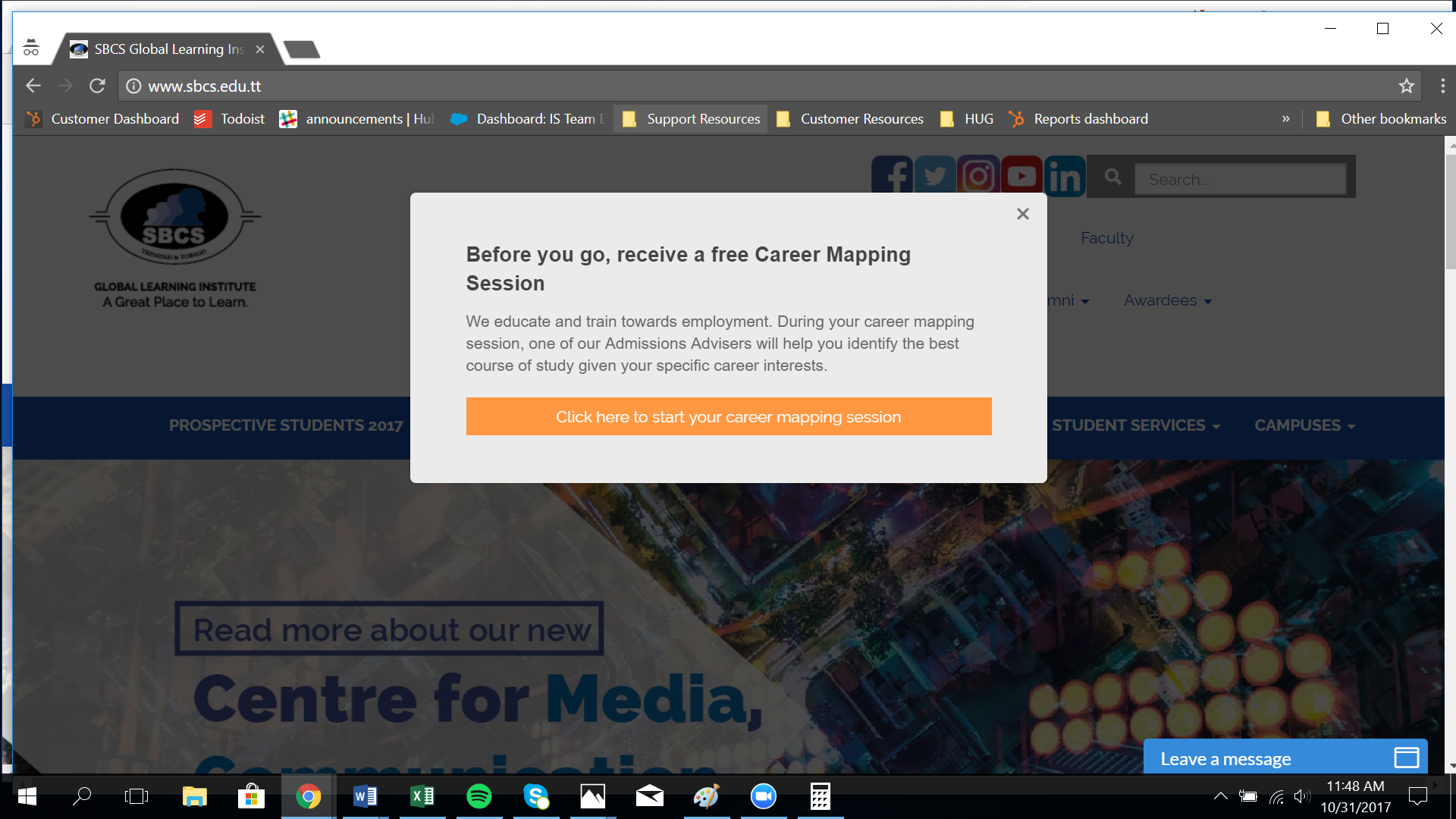 SBCS is a client of mine who started out with an 80% bounce rate on some pretty high traffic. At the time, the only resource they could volunteer was 15 minutes of their time advising students on the best way to arrange their curriculums, financial aid packages, and school tours. In the first day of setting up their pop-in, SBCS got an influx of approximately 70 prospective student requests. Suddenly, their biggest challenge was not in generating more leads but rather hiring enough admissions' staff to field the ones they were getting. All from one tiny pop-in that offered the right thing at the right time!
SBCS is a client of mine who started out with an 80% bounce rate on some pretty high traffic. At the time, the only resource they could volunteer was 15 minutes of their time advising students on the best way to arrange their curriculums, financial aid packages, and school tours. In the first day of setting up their pop-in, SBCS got an influx of approximately 70 prospective student requests. Suddenly, their biggest challenge was not in generating more leads but rather hiring enough admissions' staff to field the ones they were getting. All from one tiny pop-in that offered the right thing at the right time!
As a HubSpot evangelist, I can't help but recommend the pop-in feature included in HubSpot's free version of their marketing tool, which gives you access to the pop-in shown above. It's clean, easy to create, and integrates with HubSpot, which is an incredibly powerful marketing tool. However, if you're looking for a standalone way to take advantage of your high bounce rates, Privy and Wishpond have some pretty cool options as well.
2. Defining the bottom of your Funnel
Most clients I meet for the first time come into implementation saying that they want to use an inbound marketing strategy to create sales. When I ask them to elaborate, they go on to say that they want to do content marketing: blogs, white papers, pillar pages, and nurturing campaigns. Essentially, they're looking at top-of-the-funnel activities as a means of generating bottom-of-the-funnel (BOFU) results. If you're not familiar with all this funnel talk, brush up here.
When marketers talk about converting leads into sales, they most often believe it's going to come from visitors filling out their "Contact Us" page. Unfortunately, there are two issues with that logic.
1. The "Contact Us" page is statistically the lowest-performing page across all sites in terms of visits and engagements. Only a small percentage (think less than 5%) of the traffic that comes to your site will ever visit your "Contact Us" page to do business. Even with the best marketing strategy, you will only ever increase that by a marginal amount.
2. "Contact Us" is not a bottom-of-the-funnel offer. Most contact forms are based around this notion of, "Contact us to learn more about whether or not you have the privilege of doing business with us!" As you can imagine, this doesn't exactly thrill your prospects. It's also not an offer, in that you're not offering anything; this one-sided exchange requires that your prospects be the ones offering you their information and their time for little in return.
What happens when you don't have a true bottom to your funnel? Every lead that you spend time and money getting in through the top and nurturing through the middle ends up falling out of your marketing funnel before they can ever reach sales.
When we define and create a true BOFU offer, we're creating a destination for our marketing efforts. The offer should provide more value than its TOFU and MOFU predecessors. A good BOFU offer is one that we can insert as a call-to-action in an email chain—one that we can market on social media and through PPC efforts.
Creating that offer is simply a matter of identifying where in your sales process you create the most value and doing a bit of storytelling around that.
When you sit down with prospects, in an attempt to find a use case for your product/service, do you ask them questions around their company's infrastructure? Do you help them break down expenditures on their current solution to identify inefficiencies? Maybe you create a roadmap for how a solution through you would increase their ROI over a period of time or decrease overhead in the coming months.
Most companies' prospects are better off for having talked to them. Chances are you're doing some or all of the above in your sales process but have yet to create a narrative around it. That's a waste of potential, if you ask me. Crafting that very narrative will be your first step in creating an effective BOFU Offer.
Here's what that narrative looks like in offer mode:
 Kavaliro is a client of mine that focuses on recruiting solutions for job seekers and staffers alike. The consultation offer above is the offer they're making to staffers, and they have another one for job seekers as well. Since this has gone live, they've not only generated leads but have also funneled their incoming leads based on priorities and personas because of how fine-tuned this offer is.
Kavaliro is a client of mine that focuses on recruiting solutions for job seekers and staffers alike. The consultation offer above is the offer they're making to staffers, and they have another one for job seekers as well. Since this has gone live, they've not only generated leads but have also funneled their incoming leads based on priorities and personas because of how fine-tuned this offer is.
Their prospects are ultimately still hitting that "Contact Us" button, but it's under a different premise. That premise is a consultation whose sole aim is to to be helpful and to drive value. The beauty of this offer is that it hands this prospect off directly to the sales team. The above offer is simple, elegant, and it gets to the core of what Kavaliro's prospects truly care about.
Kavaliro is winning right now because it is a pleasure for their prospects to hop into a sales conversation, fully knowing that buy or not, they will leave better off for having attended. On the flip side, Kavaliro equally knows that if they're able to communicate the above points to their prospect base on a person-to-person basis, the chances of closing business are higher than ever before.
Find where you provide the most value, and create a narrative around it. That's your bottom-of-the-funnel offer.
For easy implementation, you can replace the content on your contact page with an offer that follows the above principles. Or, if you're looking to have something a little more reminiscent of a marketing offer, you can replicate this BOFU approach on a landing page. Kavaliro has their page built on HubSpot, but if you're not looking to purchase a marketing platform, there are some free standalone options in Ucraft and Ontra Pages. For a bit more money, you can still pursue that standalone option in a more robust manner through Unbounce.
3. Optimizing your site for search engines
You're now capturing leads before they can leave your site and have an amazing offer for those who don't. Now you have to get enough eyes on your site so that the conversion math plays out in your favor. When discussing traffic, most of my clients immediately say, "I want to increase traffic by positioning myself on social media and blogging about my expertise!"
While those are two good ways to drive traffic, optimizing for organic search will help you maximize your reach. Every "hit" your website gets from a search engine tells a story about your page and how valuable it is. If that story isn't aligned with what you want to be known for, you either won't be known at all depending on your competitive atmosphere, or you will generate the wrong kind of traffic.
Optimizing your site around SEO best practices is THE lowest hanging fruit there is because of how simple it is to execute. The hardest part about it (which also isn't that hard) is determining the keywords you want to target. There are two ways to think about which keywords you want to optimize for:
1. Keywords that define what you do as a business.
and
2. Keywords that define the problems / opportunities your prospects are facing in their own language.
For example, you can optimize a page for "scoliosis treatments" or you can optimize for "how to manage back pain." While inbound marketing best practices would suggest that you go with the latter, you should follow a data-driven approach and analyze the monthly search volume and competitiveness of each search term.
The first step is to generate that data through Google AdWord's Keyword Planner. 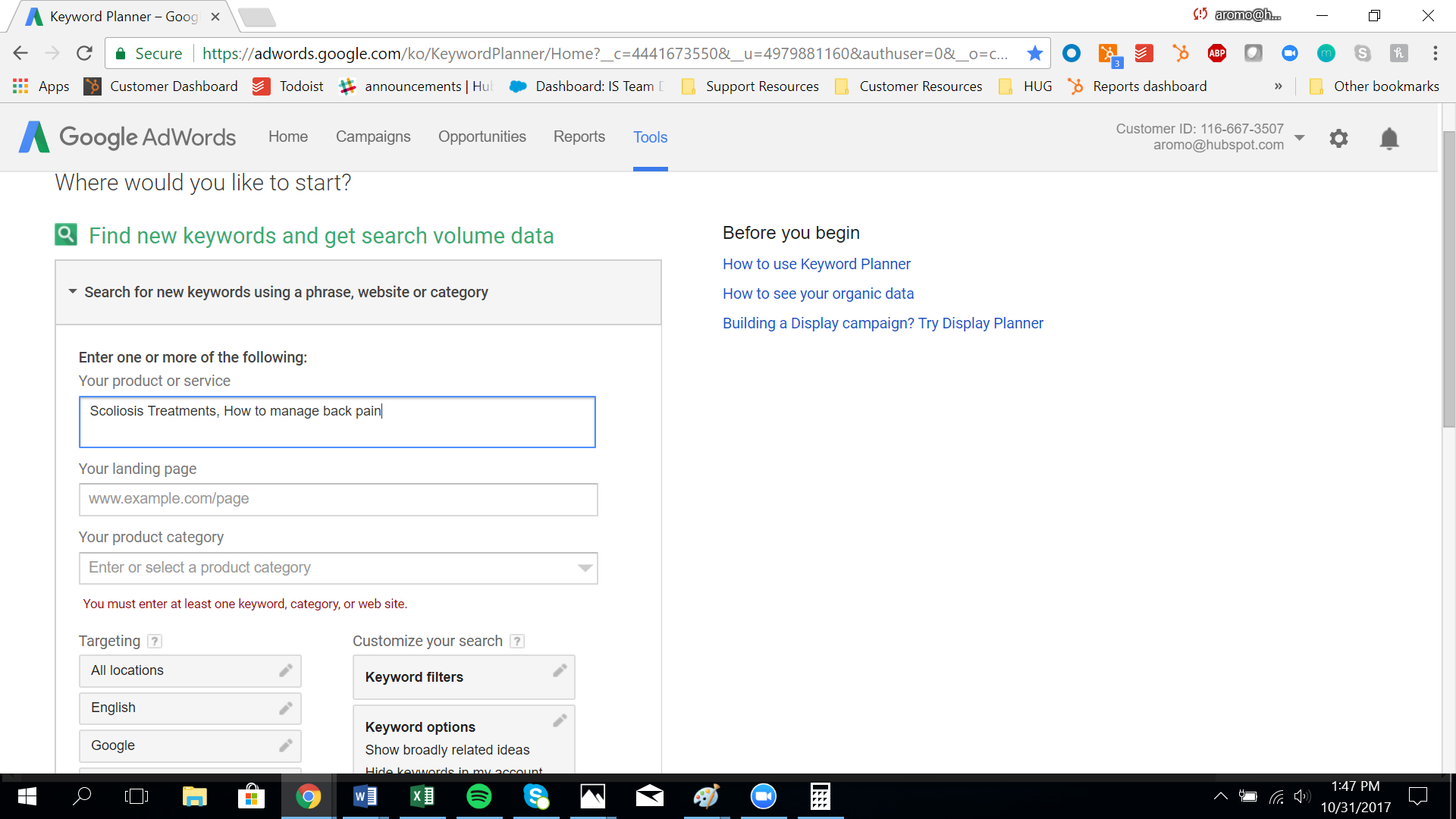
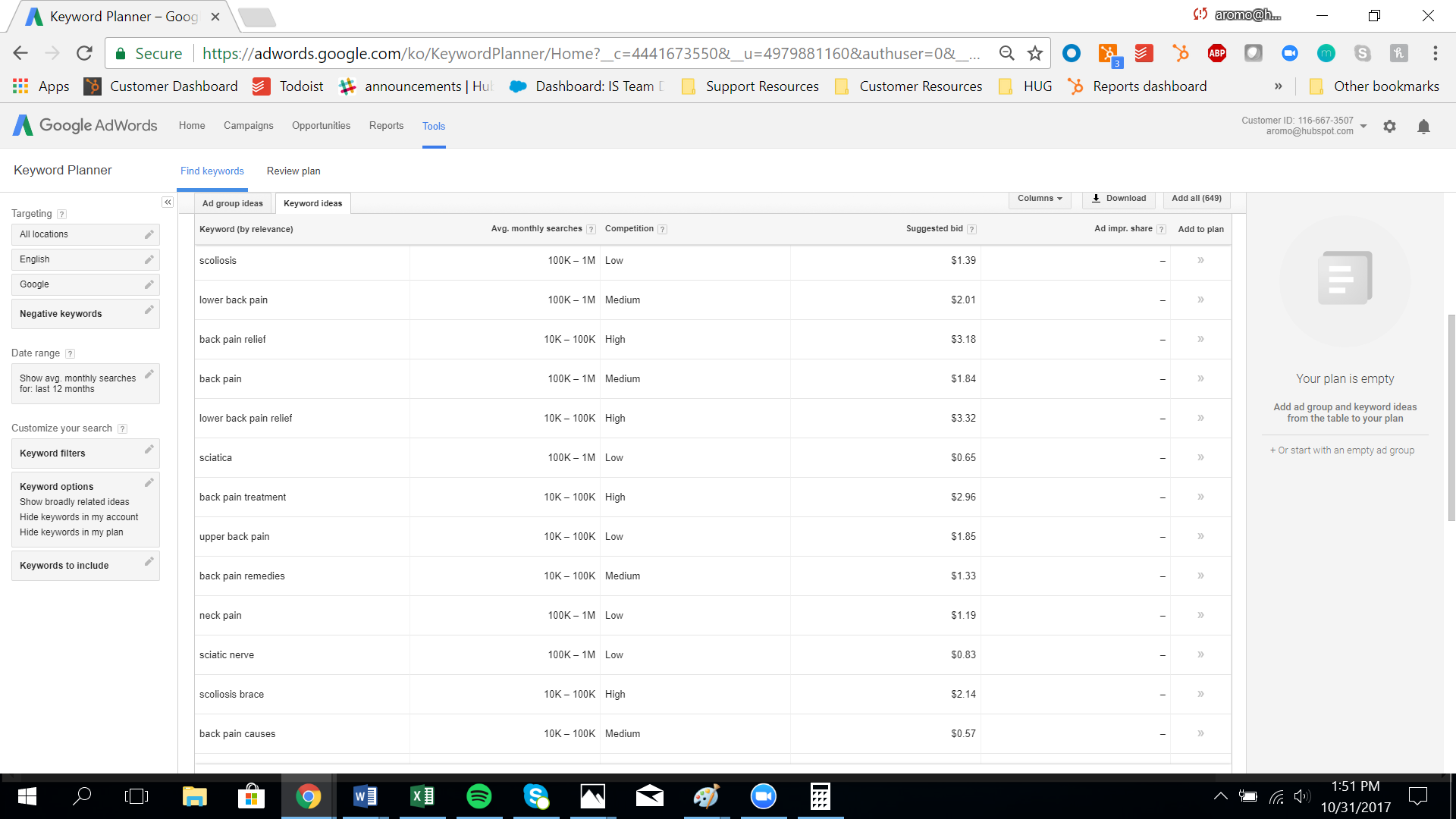 There are about 600 more keywords on the above page that you're not seeing, which you can download on your own in Excel format when you try this exercise.
There are about 600 more keywords on the above page that you're not seeing, which you can download on your own in Excel format when you try this exercise.
All 646 variations of those two words have been generated based on user data. You'll notice that once you generate variations around both words, you get a column that says "Average monthly searches" and "Competition." Average monthly searches represents just that, and competition shows a low/medium/high rating based on the number of pages that are optimized for the listed keyword.
Your job now is to sift through the list and find a group of keywords that have a high monthly search and low competition. You want keywords that are most searched and are seldom written about by competitors. This gap in the market is what you should optimize your pages for.
Now comes the easy part: actually optimizing your site. There are five places where you want to insert that strategically-chosen keyword on your site. Most of them are found in your content management system's page meta settings. These settings list your page's:
1. Page header
2. URL
3. H1 title(s)
4. Meta description
5. Content body
By placing your keyword in each of these areas, you're creating a common thread for Google to follow throughout your page that says, "This page is about X." In the examples below, you can see HubSpot has optimized its blog around "LinkedIn Headline," which is a common thread across all five on-page elements of this blog post. As a result, any search including "LinkedIn Headline" has a high chance of returning with this blog post.
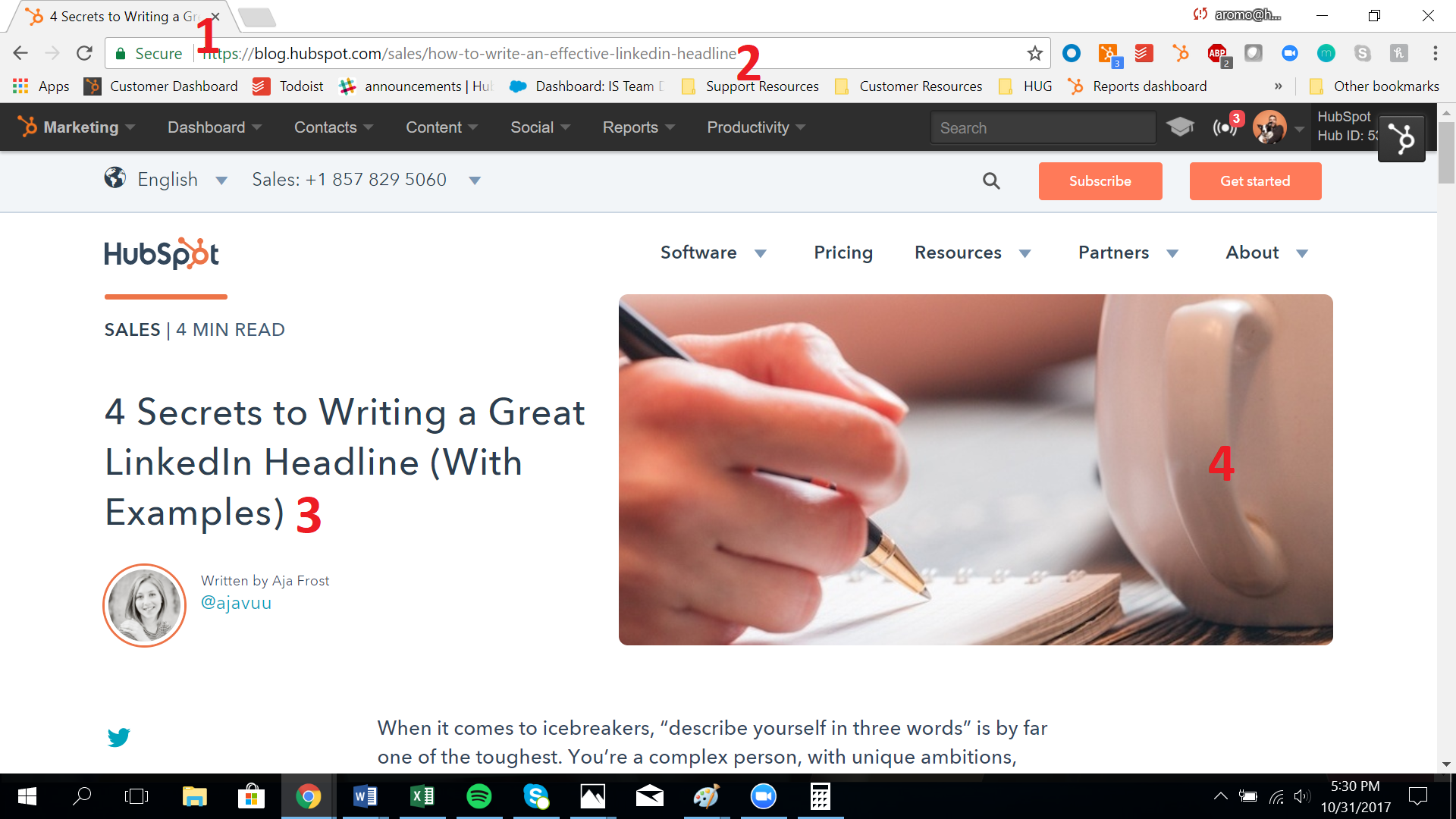
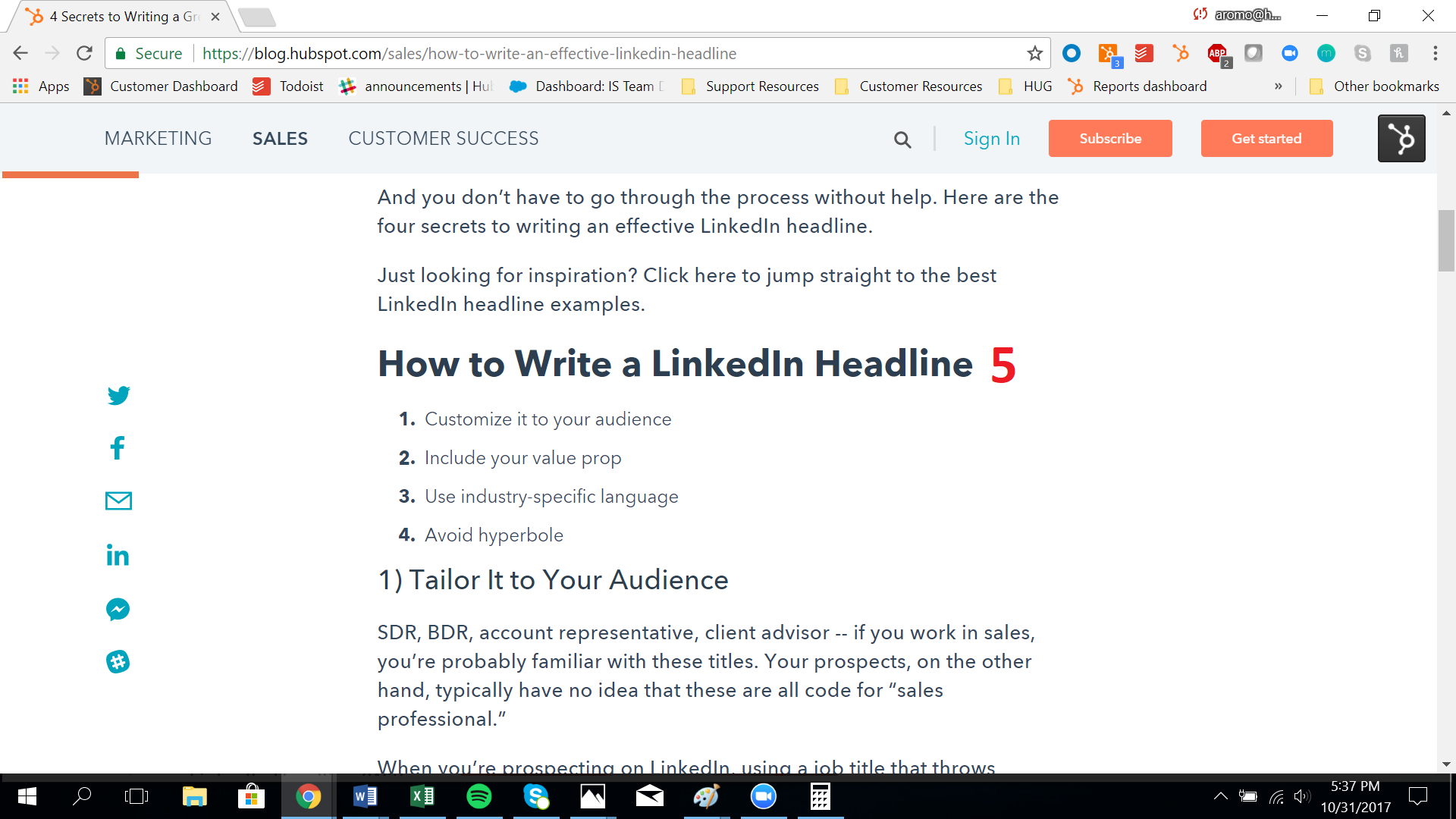
Make sure not to put more than one keyword in these places now that you know, lest you get caught keyword stuffing. Even if you think the keywords are relevant, search engines are trying to drive a good user experience. By having many keywords in these five places, you're telling search engines that your page can be around any one of X amount of topics and will undoubtedly be de-prioritized in favor a more specialized page.
As you can see, getting a marketing strategy off the ground doesn't require a huge marketing budget, just a little bit of know-how and some elbow grease. Hopefully this post has helped those of you looking to get a little more bang for your buck from your digital presence.
